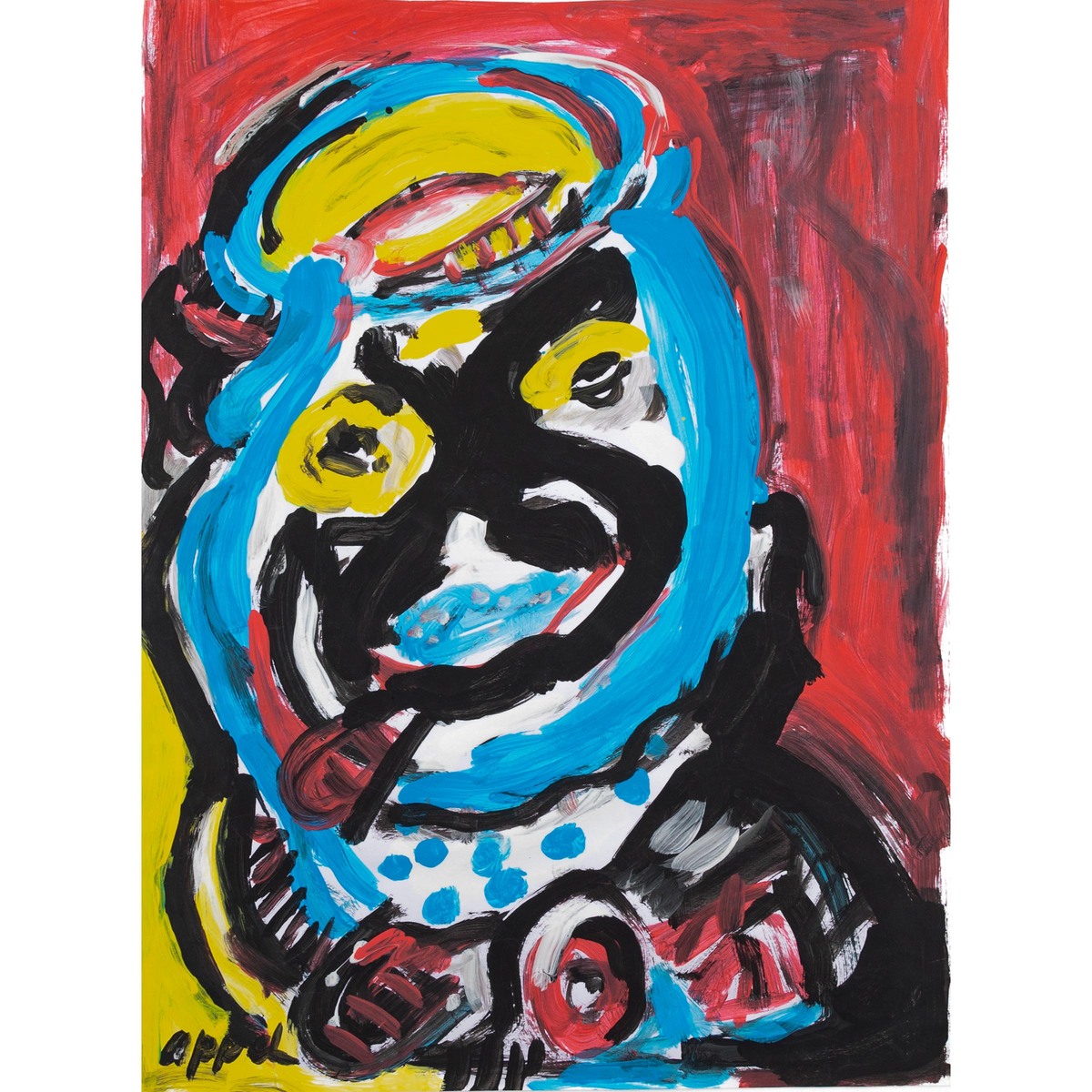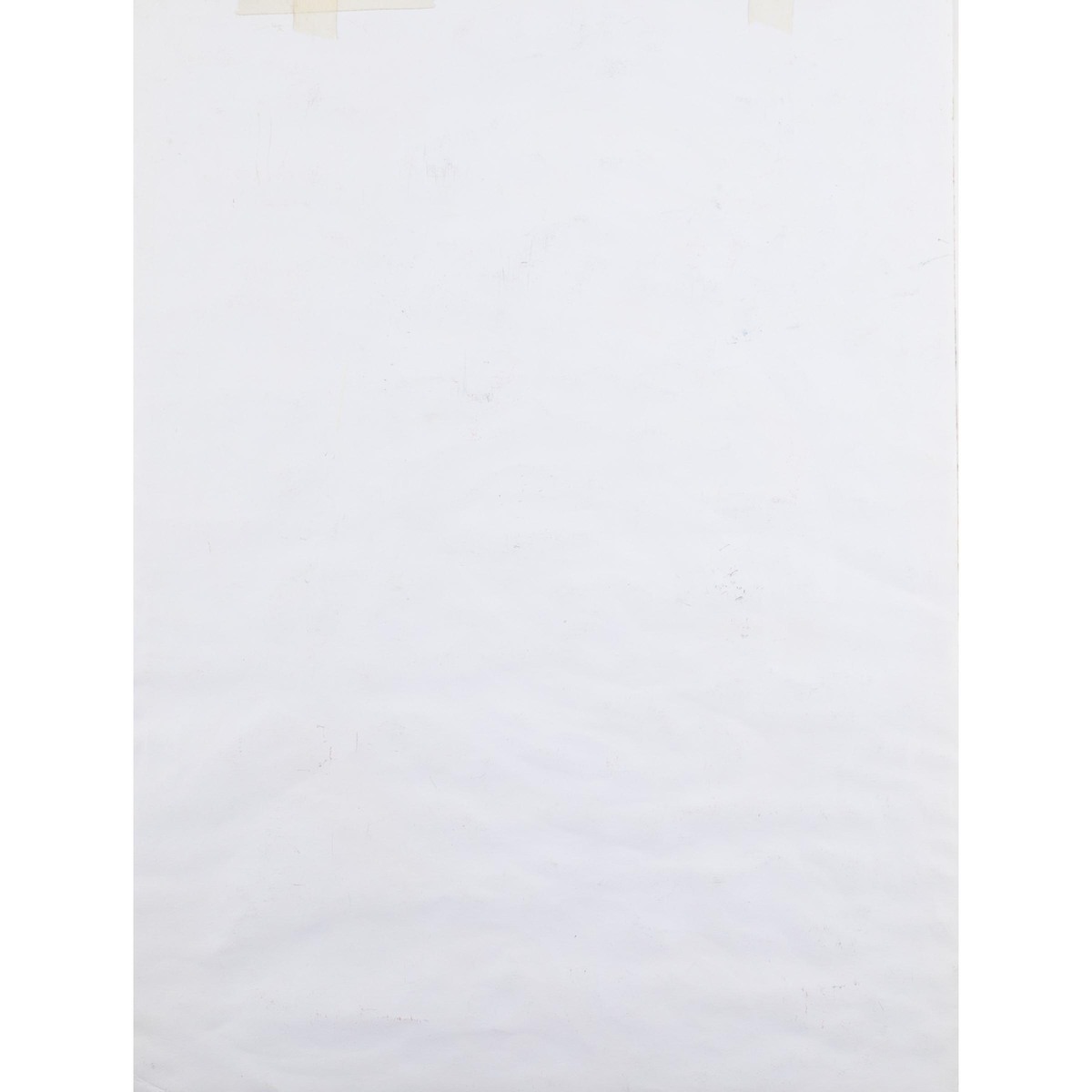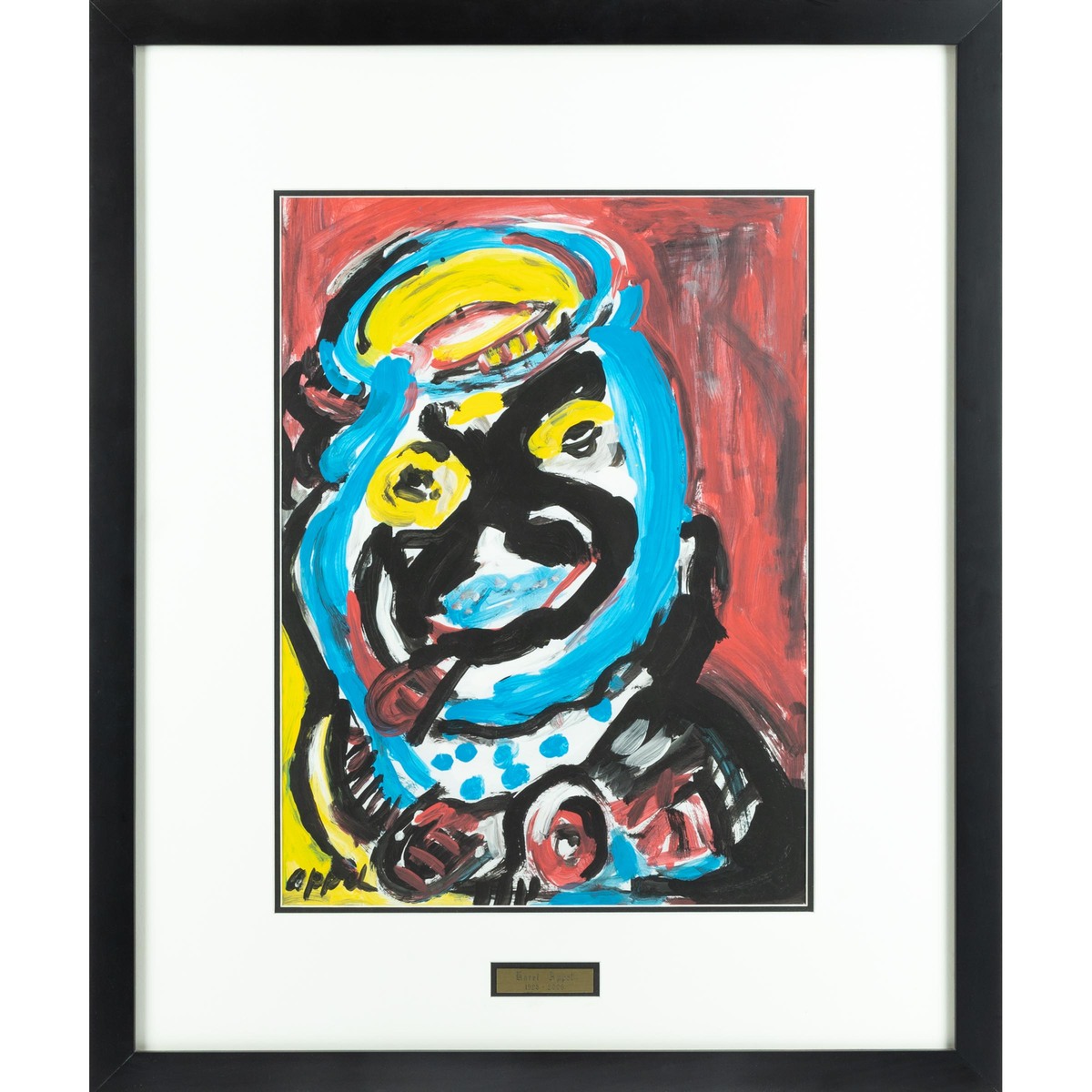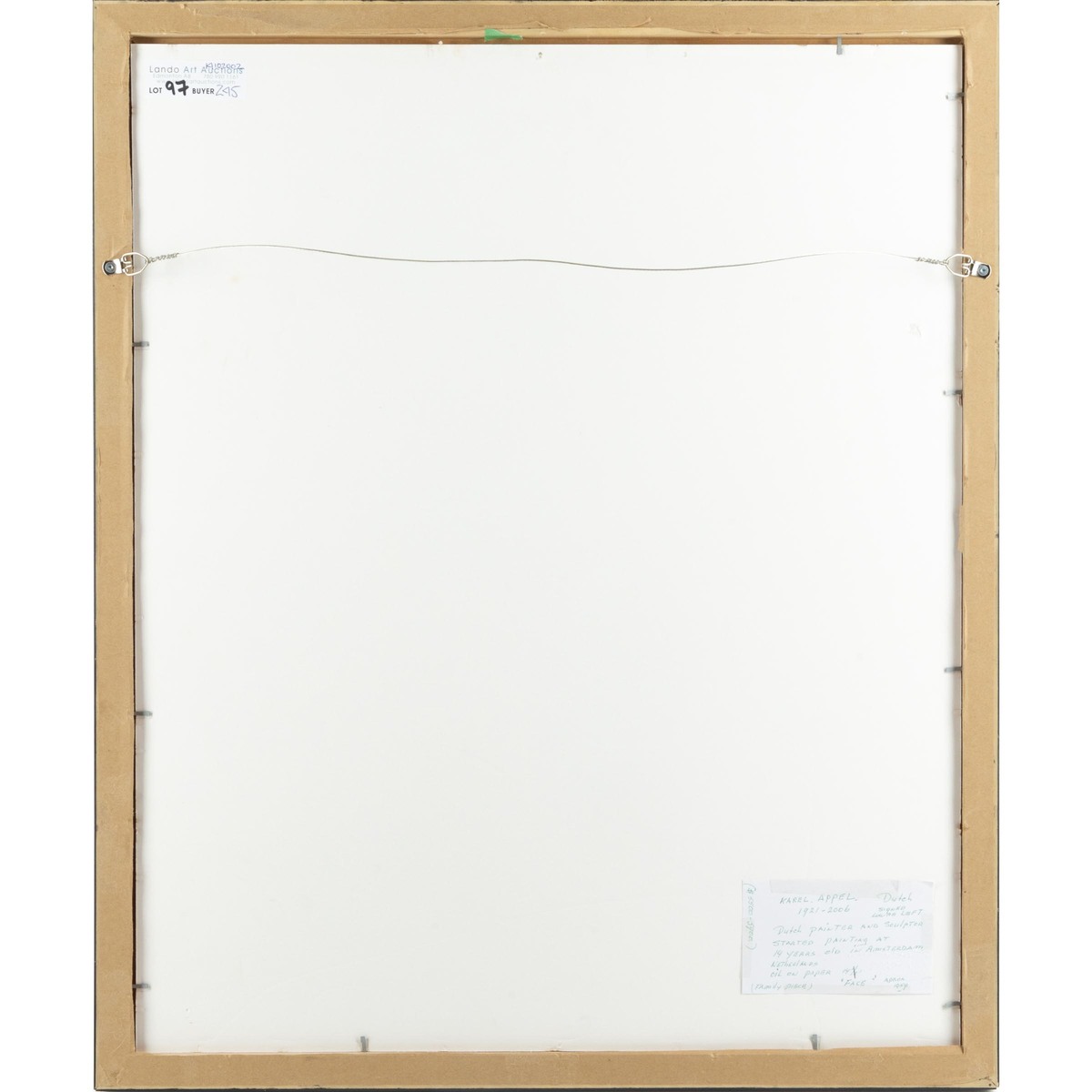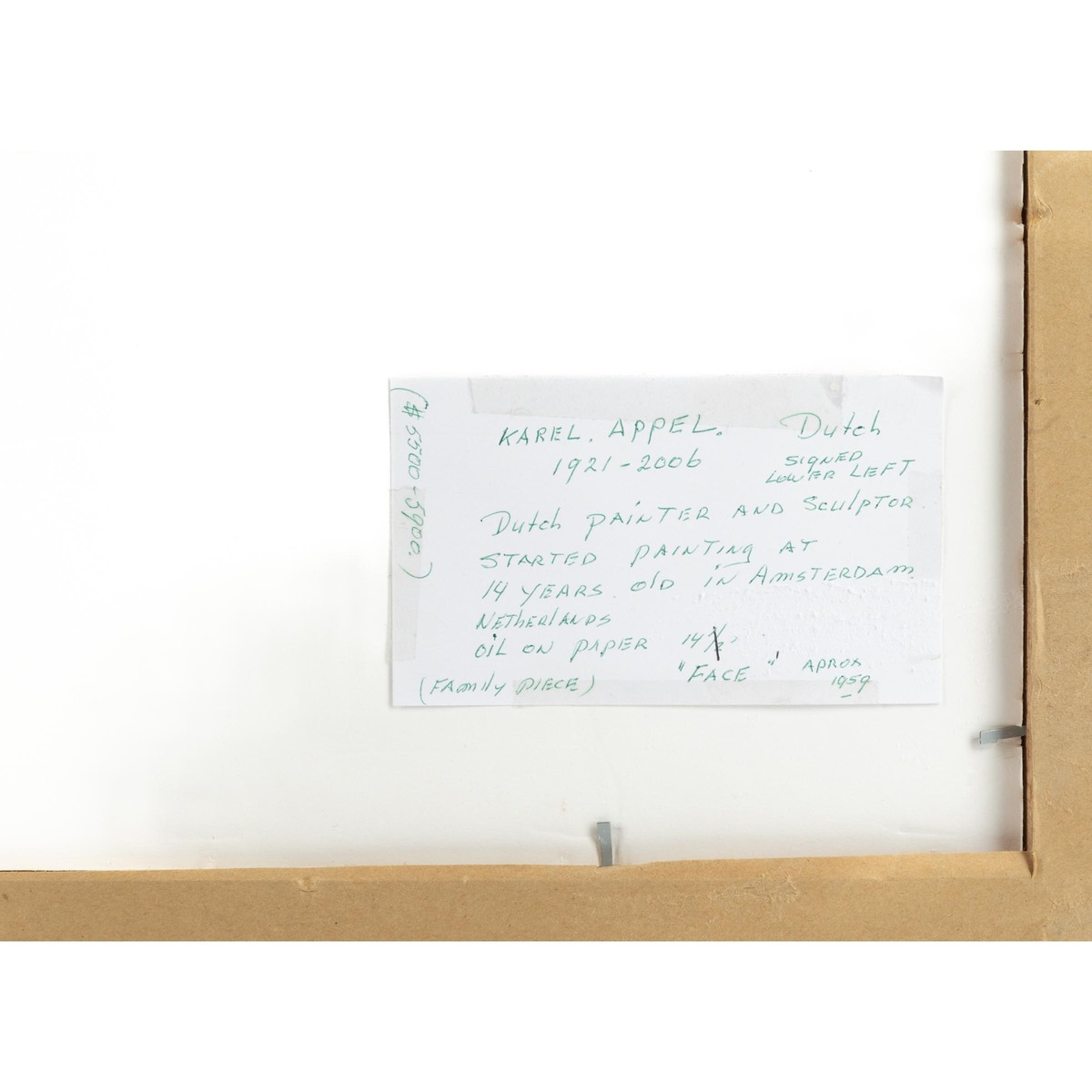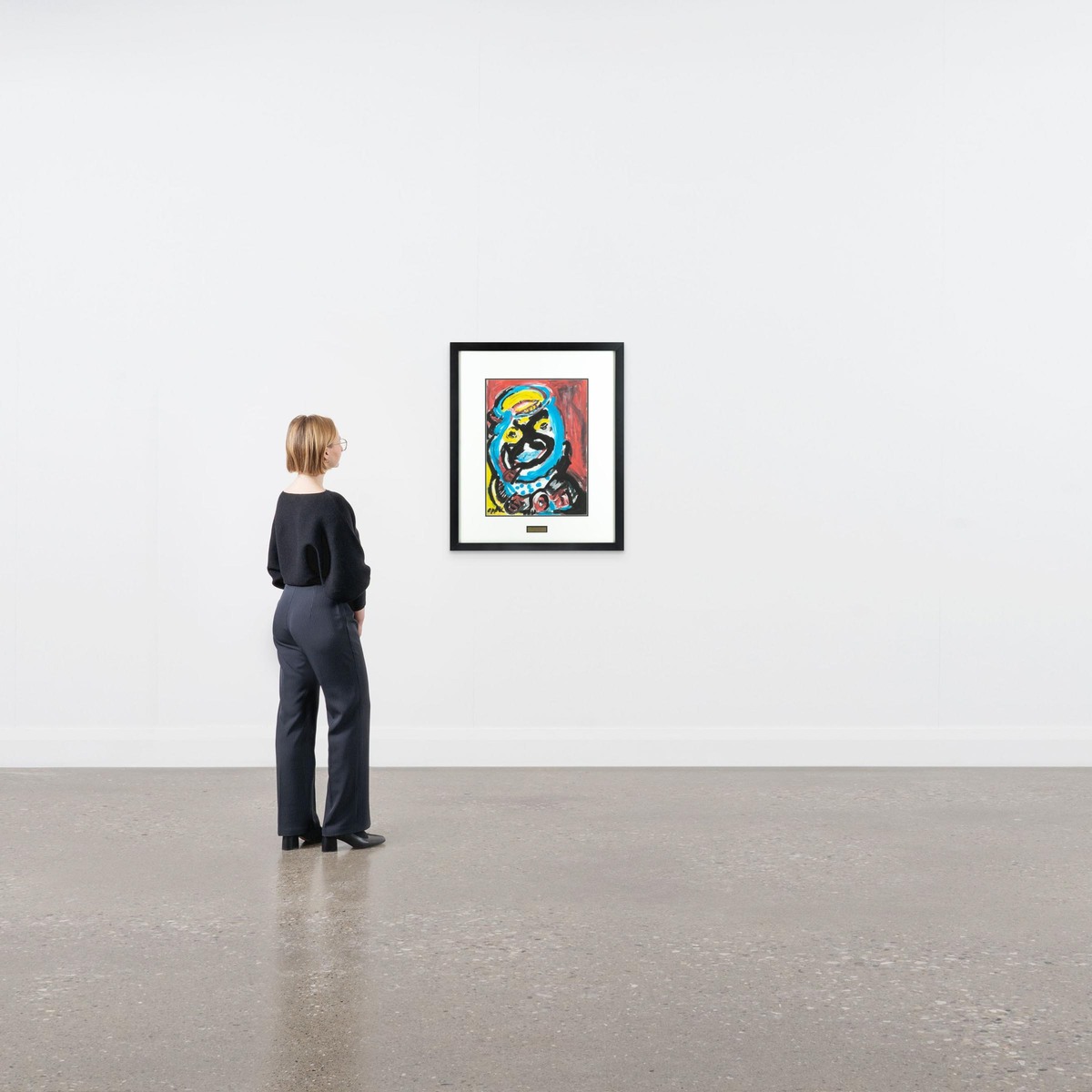36
Karel Appel (1921-2006), UNTITLED (A FIGURE), signed lower left, 18.75 x 14 in — 47.6 x 35.6 cm
UNTITLED (A FIGURE)
oil on paper
signed lower left
18.75 x 14 in — 47.6 x 35.6 cm
Provenance:
Private Collection, Alberta
Note:
Appel’s works are widely considered to embody the spirit of post-war European art; characterised by bold use of colour, expressive brushwork and a style inspired by folk art, outsider art, and children’s drawings.
His involvement with CoBrA, an avant-garde movement he founded in 1948 along with Asger Jorn, Constant and Corneille, brought attention to the young artist’s work in both Europe and North America. CoBrA, an acronym for the cities the founding artists were from (Copenhagen, Brussels, and Amsterdam), was centred around a rejection of geometric abstraction and rationalism, which CoBrA artists identified with de Stijl. De Stijl was the dominant aesthetic of Dutch art at the time, best typified by the work of Piet Mondrian. CoBrA artists also rejected the similar hegemony of French Surrealism, another major style of the period.
Their aim was to paint the human psyche in all of its disorder and primitivity, reflecting the trauma and unease of the post-war period. Brushwork was often frenetic, the colours vibrant, taking inspiration from the creativity and energy of children. Margalit Fox sums up Appel’s style accordingly: “Some critics discerned violence or even madness in Mr. Appel's work, with its liberal use of red and its semi-figurative images of grotesque limbs and distorted, grimacing faces. But to other viewers, the unrestrained masses of paint, which Mr. Appel sometimes squeezed onto the canvas straight from the tube, embodied the life force itself.”[1]
Helen A. Harrison, writing in the New York Times in 1981, explained that CoBrA’s major achievement "was in fostering an amalgam of aspects of the major trends in contemporary artistic thinking" with "the dark, mystical Northern sensibility that gives their work its peculiar character, so appropriate to postwar Europe." She added: "In short, they seem to have been able to express both optimism and anxiety at the same time."[2]
Though CoBrA disbanded in 1951, its spontaneous and colourful aesthetic has been credited with reinvigorating Dutch modern art and inspiring subsequent generations of artists. The playful spirit it promoted has also characterised Appel’s subsequent career, emblematized by thick impasto, energetic spontaneity, saturated colour and human or animal subjects. Appel recalls how formative the group was for him: "The CoBrA group started new, and first of all we threw away all these things we had known and started afresh, like a child -- fresh and new. Sometimes my works look very childish, or childlike, schizophrenic or stupid, you know. But that was the good thing for me. Because, for me, the material is the paint itself. The paint expresses itself. In the mass of paint, I find my imagination and go on to paint it."[3]
Appel began dividing his time between Europe and New York City beginning in 1957. There he would connect with Abstract Expressionist painters including Willem de Kooning, whose dramatic use of paint would influence Appel’s style. In New York, Appel’s art became even freer, though like his earlier work, continued to walk a tightrope between abstraction and figuration, never entirely one or the other. Appel also met jazz musicians Dizzy Gillespie, Miles Davis and Count Basie, whose free-flowing styles would also impact his painting.
The 1960s marked a period of decline and tragedy for Appel, when painting went out of fashion and his second wife, Machteld, passed away. But Appel and his irrepressible style could not be kept down long – Appel remarried his third and last wife, began working again, and signed on with art dealer Annina Nosei, who also represented Jean-Michel Basquiat. Appel would find fresh inspiration in the flattened aesthetics of Pop Art, which he reinterpreted using his signature style.
Appel continued to experiment until the very end of his life. He worked with various media, including sculpture, textile, ceramics, and printmaking, all which he imbued with his signature primal energy. Franz W. Kaiser, writing for the Appel Foundation, notes that “Appel early on recognizes that sticking to one’s own comfort zone inevitably leads to formalism and repetition. He consciously exposes himself again and again to the unknown. This can be a new material or a new method, but also the style of a current avant-garde, of which he takes up individual aspects and integrates them within his characteristic way of working.”[4]
[1] Margalit Fox, Karel Appel, Dutch Expressionist Painter, Dies at 85. The New York Times, 9 May 2006, accessed 2 April 2024.
https://www.nytimes.com/2006/05/09/arts/design/karel-appel-dutch-expressionist-painter-dies-at-85.html
[2] Helen A. Harrison. Art; Unfolding the Esthetics of the Cobra Group. The New York Times, 10 May 1981. Accessed 2 April 2024.
https://www.nytimes.com/1981/05/10/nyregion/art-unfolding-the-esthetics-of-the-cobra-group.html, cited in Margalit Fox, ibid.
[3] Fox, ibid.
[4] Franz W Kaiser. Biography. Karel Appel Foundation, accessed 2 April 2024.
https://karelappelfoundation.com/karel-appel/chronology
Estimate: $20,000—25,000
UNTITLED (A FIGURE)
oil on paper
signed lower left
18.75 x 14 in — 47.6 x 35.6 cm
Provenance:
Private Collection, Alberta
Note:
Appel’s works are widely considered to embody the spirit of post-war European art; characterised by bold use of colour, expressive brushwork and a style inspired by folk art, outsider art, and children’s drawings.
His involvement with CoBrA, an avant-garde movement he founded in 1948 along with Asger Jorn, Constant and Corneille, brought attention to the young artist’s work in both Europe and North America. CoBrA, an acronym for the cities the founding artists were from (Copenhagen, Brussels, and Amsterdam), was centred around a rejection of geometric abstraction and rationalism, which CoBrA artists identified with de Stijl. De Stijl was the dominant aesthetic of Dutch art at the time, best typified by the work of Piet Mondrian. CoBrA artists also rejected the similar hegemony of French Surrealism, another major style of the period.
Their aim was to paint the human psyche in all of its disorder and primitivity, reflecting the trauma and unease of the post-war period. Brushwork was often frenetic, the colours vibrant, taking inspiration from the creativity and energy of children. Margalit Fox sums up Appel’s style accordingly: “Some critics discerned violence or even madness in Mr. Appel's work, with its liberal use of red and its semi-figurative images of grotesque limbs and distorted, grimacing faces. But to other viewers, the unrestrained masses of paint, which Mr. Appel sometimes squeezed onto the canvas straight from the tube, embodied the life force itself.”[1]
Helen A. Harrison, writing in the New York Times in 1981, explained that CoBrA’s major achievement "was in fostering an amalgam of aspects of the major trends in contemporary artistic thinking" with "the dark, mystical Northern sensibility that gives their work its peculiar character, so appropriate to postwar Europe." She added: "In short, they seem to have been able to express both optimism and anxiety at the same time."[2]
Though CoBrA disbanded in 1951, its spontaneous and colourful aesthetic has been credited with reinvigorating Dutch modern art and inspiring subsequent generations of artists. The playful spirit it promoted has also characterised Appel’s subsequent career, emblematized by thick impasto, energetic spontaneity, saturated colour and human or animal subjects. Appel recalls how formative the group was for him: "The CoBrA group started new, and first of all we threw away all these things we had known and started afresh, like a child -- fresh and new. Sometimes my works look very childish, or childlike, schizophrenic or stupid, you know. But that was the good thing for me. Because, for me, the material is the paint itself. The paint expresses itself. In the mass of paint, I find my imagination and go on to paint it."[3]
Appel began dividing his time between Europe and New York City beginning in 1957. There he would connect with Abstract Expressionist painters including Willem de Kooning, whose dramatic use of paint would influence Appel’s style. In New York, Appel’s art became even freer, though like his earlier work, continued to walk a tightrope between abstraction and figuration, never entirely one or the other. Appel also met jazz musicians Dizzy Gillespie, Miles Davis and Count Basie, whose free-flowing styles would also impact his painting.
The 1960s marked a period of decline and tragedy for Appel, when painting went out of fashion and his second wife, Machteld, passed away. But Appel and his irrepressible style could not be kept down long – Appel remarried his third and last wife, began working again, and signed on with art dealer Annina Nosei, who also represented Jean-Michel Basquiat. Appel would find fresh inspiration in the flattened aesthetics of Pop Art, which he reinterpreted using his signature style.
Appel continued to experiment until the very end of his life. He worked with various media, including sculpture, textile, ceramics, and printmaking, all which he imbued with his signature primal energy. Franz W. Kaiser, writing for the Appel Foundation, notes that “Appel early on recognizes that sticking to one’s own comfort zone inevitably leads to formalism and repetition. He consciously exposes himself again and again to the unknown. This can be a new material or a new method, but also the style of a current avant-garde, of which he takes up individual aspects and integrates them within his characteristic way of working.”[4]
[1] Margalit Fox, Karel Appel, Dutch Expressionist Painter, Dies at 85. The New York Times, 9 May 2006, accessed 2 April 2024.
https://www.nytimes.com/2006/05/09/arts/design/karel-appel-dutch-expressionist-painter-dies-at-85.html
[2] Helen A. Harrison. Art; Unfolding the Esthetics of the Cobra Group. The New York Times, 10 May 1981. Accessed 2 April 2024.
https://www.nytimes.com/1981/05/10/nyregion/art-unfolding-the-esthetics-of-the-cobra-group.html, cited in Margalit Fox, ibid.
[3] Fox, ibid.
[4] Franz W Kaiser. Biography. Karel Appel Foundation, accessed 2 April 2024.
https://karelappelfoundation.com/karel-appel/chronology
Estimate: $20,000—25,000
Canadian and International Fine Art
Fine da
Indirizzo della sede
For Waddington's delivery information please telephone +1 4165049100.
Informazioni importanti
Our spring offering of Canadian and International Fine Art brings together exceptional work from around the world. This auction features celebrated Canadian artists such as Cornelius Krieghoff, A.Y. Jackson, P.C. Sheppard, A.J. Casson, Bertram Booker, Alexandra Luke, Jean Paul Lemieux and Yves Gaucher as well as important First Nations artists Norval Morrisseau, Roy Thomas and Alex Janvier. International highlights include work by Jules Olitski, Karel Appel, Kwon Young-Woo, Norman Bluhm, Józef Bakoś, Léon Lhermitte and Montague Dawson.
Please contact us to find out more.
Termini e condizioni
1. Waddington's charges a buyer's premium of 25% on the hammer price up to and including
$25,000 CAD. Hammer price in excess of $25,000 CAD will be charged a buyer's premium of
22%.
Bidders buying on the Invaluable site will be charged a buyer's premium of 28% on the hammer
price up to and including $25,000 CAD. Hammer prices in excess of $25,000 CAD will be
charged at 25%.
2. Unless exempted by law, the buyer is required to pay Federal Good and Services Tax on the
total purchase price including the buyer’s premium.
3. The auctioneer reserves the right to withdraw any lot from sale at any time, to divide any lot
or to combine any two or more lots at his sole discretion, all without notice.
4. The auctioneer has the right to refuse any bid and to advance the bidding at his absolute
discretion. The auctioneer reserves the right not to accept and not to reject any bid. Without
limitation, any bid which is not commensurate with the value of the article offered, or which is
merely a nominal or fractional advance over the previous bid may not be recognized.
5. Each lot may be subject to an unpublished reserve which may be changed at any time by
agreement between the auctioneer and the consignor. The auctioneer may bid, or direct an
employee to bid, on behalf of the consignor as agreed between them. In addition, the auctioneer
may accept and submit absentee and telephone bids, to be executed by an employee of the
auctioneer, pursuant to the instructions of prospective purchasers not in attendance at the sale.
6. The highest bidder accepted by the auctioneer for any lot shall be the buyer and such buyer
shall forthwith assume full risk and responsibility for the lot and must comply with such other
Conditions of Sale as may be applicable. If any dispute should arise between bidders the
auctioneer shall have the absolute discretion to designate the buyer or, at his option, to
withdraw any disputed lot from the sale, or to re-offer it at the same or a subsequent sale. The
auctioneer’s decision in all cases shall be final.
7. Immediately after the purchase of a lot, the buyer shall pay or undertake to the satisfaction of
the auctioneer with respect to payment of the whole or any part of the purchase price requested
by the auctioneer, failing which the auctioneer in his sole discretion may cancel the sale, with or
without re-offering the item for sale.
8. The buyer shall pay for all lots within 48 hours from the date of the sale, after which a late
charge of 2% per month on the total invoice may be incurred or the auctioneer, in his sole
discretion, may cancel the sale. The buyer shall not become the owner of the lot until paid for in
full. Items must be removed within 10 days from the date of sale, after which storage charges
may be incurred.
9. Each lot purchased, unless the sale is cancelled as above, shall be held by the auctioneer at
his premises or at a public warehouse at the sole risk of the buyer until fully paid for and taken
away.
10. All lots are sold “AS IS”. Any description issued by the auctioneer of an article to be sold is
subject to variation to be posted online and/or announced via email prior to the time of sale.
While the auctioneer has endeavored not to mislead in the description issued, and the utmost
care is taken to ensure the correct cataloguing of each item, such descriptions are purely
statements of opinion and are not intended to constitute a representation to the prospective
purchasers and no warranty of the correctness of such description is made. Some lots are of an
age and/or nature which preclude their being in pristine condition and some catalogue
descriptions make reference to damage and/or restoration. The lack of such a reference does
not imply that a lot is free from defects nor does any reference to certain defects imply the
absence of others. It is the responsibility of prospective purchasers to inspect or have inspected
each lot upon which they wish to bid and to bid accordingly.
11. Payment for purchases must be by cash; INTERAC direct debit (CDN client in person only);
certified cheque (U.S. & Overseas not applicable); bank draft; E-Transfer; Wire Transfer (fee
applies); VISA or Mastercard (up to $25,000).
12. In the event of failure to pay for or remove articles within the aforementioned time limit, the
auctioneer, without limitation of the rights of the consignor and the auctioneer against the buyer,
may resell any of the articles affected, and in such case the original buyer shall be responsible
to the auctioneer and the consignor for:
(a) any deficiency in price between the re-sale amount and the amount to have been paid by
the original buyer
(b) any reasonable charge by the auctioneer for the storage of such articles until payment and
removal by the subsequent buyer and
(c) the amount of commission which the auctioneer would have earned had payment been
made in full by the original buyer.
13. It is the responsibility of the buyer to make all arrangements for insuring, packing and
removing the property purchased and any assistance by the auctioneer or his servants, agents
or contractors, in packing or removal shall be rendered as a courtesy and without any liability to
them.
14. The auctioneer acts solely as agent for the consignor and makes no representation as to
any attribute of, title to, or restriction affecting the articles consigned for sale. Without limitation,
the buyer understands that any item bought may be affected by the provisions of the Cultural
Property Export Act (Canada).
15. The auctioneer reserves the right to refuse admission to the sale or to refuse to recognize
any or all bids from any particular person or persons at any auction.
















